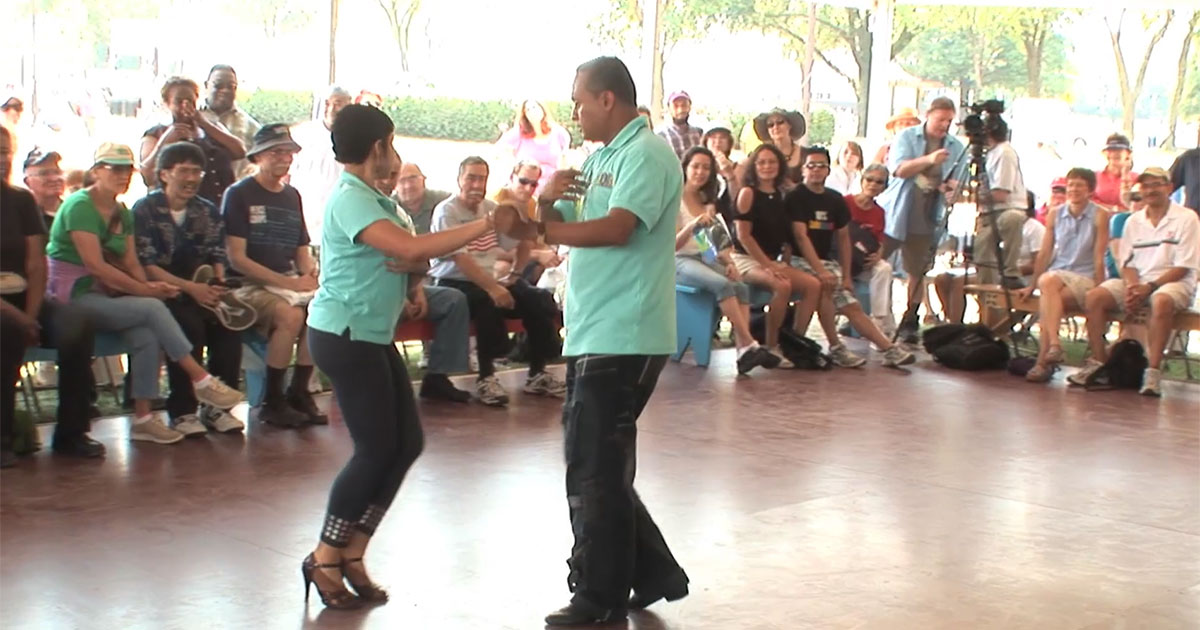At the Festival, dance may be presented as an integral part of a music style, as in the case of joropo from the Colombian Southeastern plains where the dancer's stepping forms part of the percussion. Dance styles may also be featured performances; and if resources are limited, it may be presented with recorded music, as in the case of salsa and tango performances in the Colombia program. In both cases, the formal part of the dance presentation is typically followed by demonstrations that encourage audience participation. As in the case of salsa and tango, dance forms may also be presented in workshop formats.
Arnulfo Pinto García and Magdalena Plazas Lugo from Grupo Cabrestero dance joropo.
Photo by Hugh Talman, Ralph Rinzler Folklife Archives and Collections, Smithsonian Institution
Johanna Palacios Ruiz and Edinson Dario Vanegas from Tango Medellín perform tango dance at the Al Son Que Me Toquen Stage.
Photo courtesy of the Embassy of Colombia in Washington, D.C.
Johanna Palacios y Édinson Vanegas bailan tango en el escenario Al son que me toquen
Luz Aydé Moncayo and Deivy Johan Zúñiga demonstrate basic steps during a salsa dance workshop.
Photo courtesy of the Embassy of Colombia in Washington, D.C.
Luz Aydé Moncayo and Deivy Johan Zúñiga from Salsa de Cali demonstrate an impressive pose during a dance workshop.
Photo courtesy of the Embassy of Colombia in Washington, D.C.
Johanna Palacios Ruiz and Edinson Dario Vanegas from Tango Medellín perform tango at the Al Son Que Me Toquen Stage.
Photo courtesy of the Embassy of Colombia in Washington, D.C.
Laura Jeannette Alba and Jorge Alberto Rodríguez balance bottles on their head for the Guabina during a dance workshop.
Photo courtesy of the Embassy of Colombia in Washington, D.C.
Laura Jeannette Alba and Jorge Alberto Rodríguez dance Carranga during a workshop at El Rumbeadero.
Photo courtesy of the Embassy of Colombia in Washington, D.C.
Arnulfo Pinto García and Magdalena Plazas from Grupo Cabrestero dance Joropo during a performance at Al Son Que Me Toquen Stage.
Photo courtesy of the Embassy of Colombia in Washington, D.C.
Laura Jeannette Alba and Jorge Alberto Rodríguez dance a Guabina during a performance at Al Son Que Me Toquen Stage.
Photo courtesy of the Embassy of Colombia in Washington, D.C.
Luz Aydé Moncayo and Deivy Johan Zúñiga lead a Cali-style salsa dance workshop.
Photo courtesy of the Embassy of Colombia in Washington, D.C.
Dance performances tend to be visually exciting and therefore attract some of the biggest audiences. Because much of the significance of dance is non-visual and not obvious to the observer, presenters must provide background on the traditions and groups. To do this they coordinate with participants to carve out space before and at appropriate times during presentation about:
- The dance style; its regional importance; and how the dance interacts with the music;
- The significance of dress;
- Traditional performance settings;
- The general meaning and function of the dances
Presenters also encourage the ensemble leaders themselves to discuss the dance in brief discursive exchanges. They plan such interludes only after consulting with the artists to ensure that they are comfortable having these.
More Video















